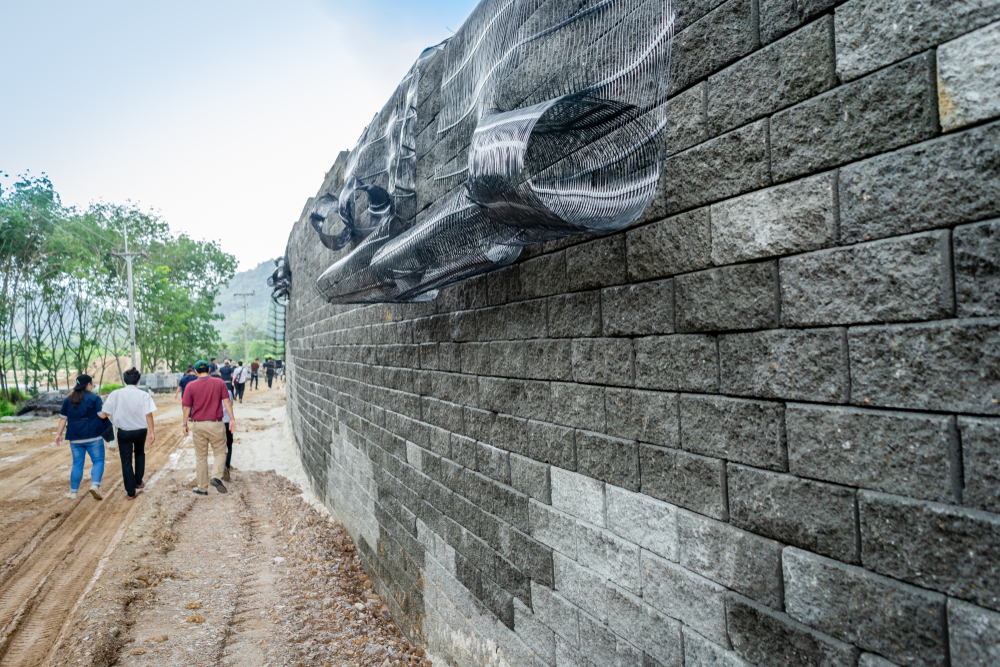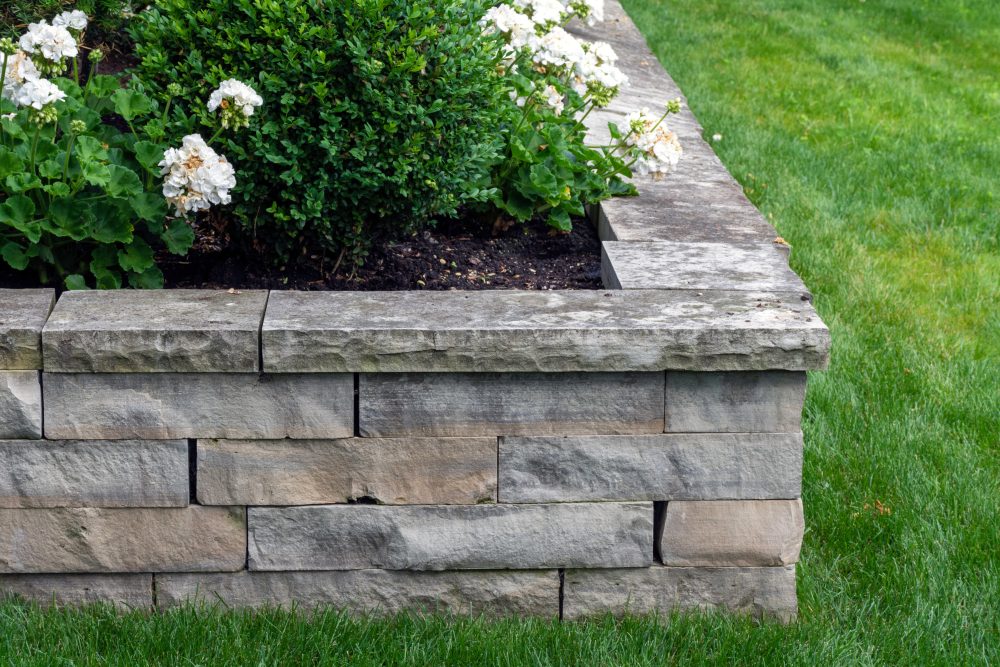Secret Factors To Consider for Structure Effective Retaining Walls in Your Lawn
When you're thinking about building a maintaining wall surface in your lawn, it's vital to assume concerning numerous crucial elements. The wall's objective, the materials you'll make use of, and the specific dirt problems can all influence its efficiency and long life.
Understanding the Function of Your Retaining Wall
When you consider building a retaining wall, consider its main function: maintaining soil and preventing disintegration. Retaining walls offer essential assistance for sloped landscapes, assisting to preserve soil integrity. You'll find they're vital in locations where water drainage may or else clean away soil, resulting in pricey repairs and landscape damages.
By holding back planet, these walls develop degree surfaces for yards, patio areas, or pathways. This not only boosts your lawn's looks however additionally promotes far better drain, lowering water pooling in unwanted locations. If you're taking care of high slopes, a sound retaining wall surface can prevent landslides, making sure security for you and your building.
Eventually, comprehending the purpose of your retaining wall surface will certainly lead your design choices and help you produce a functional, sturdy structure that meets your needs. So, take a minute to assess your landscape; it'll pay off in the lengthy run.
Choosing the Right Products
When selecting products for your retaining wall, you'll wish to take right into account durability, looks, and cost. Each variable plays a necessary role in guaranteeing your wall stands the examination of time while looking fantastic and fitting your budget. Allow's discover just how to make the very best options for your job.
Product Resilience Aspects
Selecting the best materials is crucial for the long life and effectiveness of your retaining wall, because their resilience straight impacts the wall's capability to hold up against ecological stresses. Start by considering your regional environment; materials like concrete and rock withstand wetness and temperature variations well. If you stay in an area prone to heavy rains, opt for materials with good drainage homes, like gravel or porous blocks, to avoid water buildup.
In addition, consider the dirt problems on your residential or commercial property. Some products do better in certain dirt kinds, so it is very important to match them appropriately. Be mindful of possible wear from parasites or erosion. Picking long lasting products guarantees your retaining wall surface stands strong, shielding your backyard for many years ahead.
Aesthetic Design Selections
Long lasting products not only ensure your retaining wall's architectural integrity yet likewise play a vital role in its aesthetic charm. When selecting the appropriate products, consider just how they match your landscape. Natural rock offers an ageless, rustic appearance, while concrete blocks can give a sleek, contemporary finish. You might also consider using timber for a cozy, organic feel. Color and structure matter, as well; choose shades that balance with your home and yard. Don't forget the wall's shape-- rounded walls can produce a softer look, while straight lines can feel more organized. By thoroughly picking products that straighten with your visual vision, you'll improve your outdoor room while ensuring your wall stands solid against the components.
Cost-Effectiveness Analysis
Picking the best materials for your retaining wall surface isn't simply regarding visual appeals; it's likewise crucial for your spending plan. When selecting products, think about both upfront costs and lasting durability.
Do not neglect to variable in maintenance costs too (OKC Precision Retaining Walls). Some materials, like all-natural rock, can add charm and need less upkeep, while others may need normal treatments
Inevitably, consider the pros and disadvantages of each alternative versus your spending plan and the wall's desired purpose. Investing intelligently in materials now can avoid pricey issues later on. Pick products that balance price and efficiency properly.
Analyzing Soil Problems and Drainage
As you begin your project, assessing soil conditions and drainage is necessary for the success of your retaining wall. Start by analyzing the sort of soil in your backyard. Sandy soil drains pipes well but lacks security, while clay soil can preserve dampness, bring about pressure on your wall. Check the soil's moisture material by excavating a little opening and observing just how rapidly it dries.
Following, analyze the incline of your lawn. If water naturally flows toward your wall surface, you'll need to execute a drainage option to prevent erosion and pressure build-up. Take into consideration setting up perforated pipelines or gravel backfill behind the wall surface to assist in drain.
Last but not least, observe any nearby trees or plant life; their origins can affect soil security. By recognizing your soil problems and carrying out appropriate drain, you'll produce a solid structure for your retaining wall that stands the examination of time.
Adhering To Local Structure Codes
Prior to you begin constructing your retaining wall surface, you need to study local policies to guarantee conformity. It's important to understand what permits you have to acquire, as this can conserve you from costly penalties or needing to redesign your job. Taking these actions seriously content will assist you develop a secure and efficient framework.
Research Study Local Regulations
Recognizing local laws is vital when preparing your retaining wall surface job, specifically given that constructing codes can differ substantially by area. Begin by talking to your neighborhood building useful source department or town to learn about certain needs. Look for standards on wall surface elevation, products, drainage systems, and architectural integrity. Many areas have restrictions on the kinds of materials you can utilize and just how high you can develop. You'll additionally intend to take into consideration the zoning laws that may affect your project. Neglecting these guidelines can lead to pricey fines or the demand to redesign your work. By doing your study upfront, you can guarantee your retaining wall surface satisfies all essential codes and blends effortlessly into your yard.
Acquire Essential Licenses
As soon as you've looked into regional guidelines, the following action is to obtain the essential licenses for your retaining wall task. They may require details plans or design analyses, specifically for larger walls. Securing the right authorizations can conserve you from costly fines or having to dismantle your wall later on.

Planning the Layout and Aesthetic Appeal
As you commence intending the style and aesthetics of your retaining wall, consider exactly how it will certainly integrate with the surrounding landscape. Consider the materials you'll utilize-- stone, block, or concrete-- and exactly how they'll complement your home's architecture and the all-natural aspects in your lawn. Pick shades and appearances that blend perfectly with existing attributes like patio areas, paths, or gardens.
Next, envision the wall's shape and elevation. Bent walls can soften a rigid landscape, while straight lines may share a more contemporary appearance. Do not fail to remember to integrate plants and plant around the wall for an all-natural touch; this can enhance its allure and integrate it into the atmosphere.
Lastly, keep in mind performance. Your design must not just be aesthetically pleasing yet likewise offer its function properly. By attentively intending these elements, you'll create a keeping wall surface that improves your lawn's elegance while meeting its architectural function.
Calculating Elevation and Density Needs
To construct a strong retaining wall surface, you require to precisely determine its height and thickness requirements based upon the soil conditions and the height of the incline it will certainly support. Beginning by assessing the slope's angle and the type of soil, as different soils apply differing amounts of pressure.
For walls over 4 feet high, consider a density of at why not try this out least 12 inches. If the wall surface is taller, boost the thickness proportionally to keep security.
Next, compute the elevation of the wall surface by measuring the upright range it needs to retain. For each foot of height, you must normally prepare for a density of one-third of the wall's elevation.
Always keep in mind to represent extra elements like water drainage and backfill, which can influence your wall surface's style. Proper estimations now assure your retaining wall stands solid and lasts for several years to come.
Upkeep and Durability Considerations
While preserving your retaining wall surface may feel like a reduced concern, overlooking it can lead to considerable issues with time. Routine examinations are essential; check for fractures, protrudes, or any kind of indicators of water damage. Attending to these issues early can save you from pricey repair work down the road.
Maintain an eye on drain systems, as well. Blocked drains can create water to construct up, putting in pressure on your wall and jeopardizing its security. Clear particles and guarantee correct circulation to keep longevity.
You may likewise wish to assess sealing your wall to protect it from moisture and weathering. Relying on the material, this could need reapplication every few years.
Last but not least, landscaping around your wall surface can support its integrity. Avoid planting large trees close by, as their origins can weaken the foundation. With aggressive maintenance, your retaining wall surface can serve you well for many years ahead.

Often Asked Questions
Can I Build a Retaining Wall by Myself, or Should I Employ a Professional?
You can definitely build a keeping wall on your own if you have the right tools and expertise. Nonetheless, working with a specialist guarantees it's done appropriately, particularly for bigger or more complex structures. Consider your skill level prior to deciding.
What Are the A Lot Of Common Blunders Made When Building Retaining Walls?
When building retaining walls, you may neglect proper water drainage, avoid making use of the right materials, or forget reinforcement. These usual errors can result in architectural failing, so take your time and strategy meticulously to prevent concerns.
Just how Do I Know if My Retaining Wall Demands Support?
You'll understand your retaining wall requires reinforcement if you discover splits, leaning, or protruding. Check for water pooling behind it or soil disintegration near the base. Address these signs immediately to stop additional damage.
What Plant kingdom Appropriate for Landscaping Around a Retaining Wall?
When landscaping around a maintaining wall surface, think about utilizing low-maintenance plants like succulents, ornamental yards, or slipping ground covers - OKC Precision Retaining Walls. They'll prosper in those problems and add charm while avoiding soil erosion around your wall
How Can I Protect Against Erosion Around My Retaining Wall?
To stop disintegration around your retaining wall, you can grow ground cover, use mulch, and install drainage systems. Regularly look for water buildup and readjust landscaping to redirect runoff far from the wall.